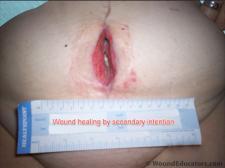Three Types of Wound Closure
It is sometimes easy to forget when we are caught up in complex treatment protocols, or when we are surrounded by paperwork, that the one thing that really matters in wound management is achieving wound closure. When a wound has closed properly, our work is done. Given the fundamental nature of wound closure, it is worth spending a few moments recapping what we know about the subject.
- Primary Wound Closure – Wound closure happens in one of three ways. Primary wound closure is the fastest type of closure- is also known as healing by primary intention. Wounds that heal by primary closure have a small, clean defect that minimizes the risk of infection and requires new blood vessels and keratinocytes to migrate only a small distance. Surgical incisions, paper cuts, and small cutaneous wounds usually heal by primary closure. These wounds do not usually trouble the wound care specialist.
- Secondary Closure – Secondary wound closure, also known as healing by secondary intention, describes the healing of a wound in which the wound edges cannot be approximated. Secondary closure requires a granulation tissue matrix to be built to fill the wound defect. This type of closure requires more time and energy than primary wound closure and creates more scar tissue. The majority of wounds close by secondary wound closure.
- Delayed Primary Closure – Occasionally, wounds are closed by delayed primary closure, also known as healing by tertiary intention. Delayed primary closure is a combination of healing by primary and secondary intention and is usually instigated by the wound care specialist to reduce the risk of infection. In delayed primary closure, the wound is first cleaned and observed for a few days to ensure no infection is apparent before it is surgically closed. Examples of wounds that are closed in this way include traumatic injuries such as dog bites or lacerations involving foreign bodies.
To further refresh your memory about the types of wound closure and other principles learned during training, consider becoming certified in wound care. Wound care certification is the ideal way to refresh your knowledge, renew your skills, and demonstrate your commitment to the discipline.
Learn More with Our Online Wound Care Certification Courses
Interested in learning more about wound care certification? Browse through our wound care certification courses for information on our comprehensive range of wound care education and wound care certification options to suit healthcare professionals across the full spectrum of qualifications and experience. Our online wound care courses are a fraction of the cost of traditional wound care courses and provide maximum continuing education hours.
References
Myers BA. Wound management principles and practice. 2nd ed. Upper Saddle River, NJ: Pearson; 2008.


Thank you so much for this great introductory on wound closure. It has helped me better understand wound healing.
I feel inspired to learn more about wound care!
Regards Ally
Thank you for visiting WoundEducators.com Ally! Our full wound care courses can be found here – https://woundeducators.com/wound-care-certification-courses/
Hi, I do think this is a great blog. I stumbledupon it ;
) I may come back yet again since i have saved ass a favorite it.
Money and freedom is the greatest way to change, may you be rich aand continue
to help others.
What happenw with secondary wound closure when the surgical hole gets too small to pack, yet some tunneling remains
Martin, thanks for your inquiry.
Generally, when a wound is too small to pack it will close, however, every wound is different would need to be evaluated by a professional.
Thank you very much for this great introduction to the wound care and management. I think I will have to make some plans on how to enroll for a certificate in wound management and care.